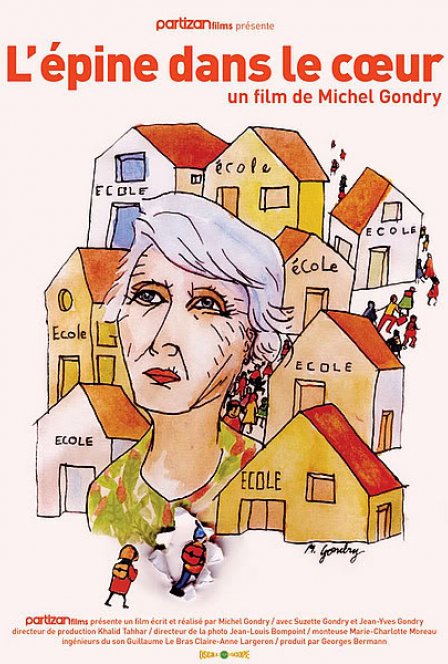Michel Gondry’s The Thorn in the Heart arrives in this country with surprisingly little fanfare for a project from such an acclaimed director. Yet despite American audiences’ familiarity with Gondry, the relatively muted release of his new documentary may be appropriate. The film’s quaint and highly personal subject matter seems a significant departure for the director, who has made a two-decade career in music videos and films by combining an exuberant artistic aesthetic with the crossover star power of figures such as Jim Carrey, Gael García Bernal, Jack Black, and Dave Chappelle. The Thorn in the Heart does not stridently engage the viewer as does, say, The Science of Sleep, but rather invites one into its own little space, offering the opportunity to sit and ruminate for a while on the nature of family, place, and documentary itself.
Taken most simply, The Thorn in the Heart is a retrospective look back on the life of Gondry’s septuagenarian aunt, Suzette Gondry. Using an array of cinematic techniques ranging from interviews and old home movie footage to Gondry’s trademark lo-fi animations, the film gradually fleshes out Suzette’s life and career and the impact she has had on those around her, particularly her son Jean-Yves. Suzette’s life’s work as a primary school teacher in rural France lends the film its structure, as Gondry organizes his narrative into episodes corresponding to reminiscing visits to Suzette’s various old schoolhouses and classrooms. Through this framework, Gondry weaves an intimate portrayal of familial dynamics within the Gondry clan that brushes against a cultural history of late-20th century France.
Of course Gondry does not fully resist bringing his customary visual whimsy to the project. He interjects handmade animations periodically throughout the film to illustrate inaccessible images from the past, such as the former film projection capabilities of a crumbled schoolhouse. A model train set, shot in close-up to appear life-sized, introduces the towns and years covered in each of the film’s episodes. (Late in the film, this particular train set gains poignant personal and symbolic significance). These aesthetic touches are matched by occasional narrative digressions into Gondry’s DIY filmmaking process itself. In a subtle act of performativity, Gondry discusses with Suzette his use of a whieelchair as a dolly to film her in a tracking shot walking down the street. The Thorn in the Heart thus acknowledges and celebrates the documentary as an act of creation and re-creation rather than a simple process of documentation. When Gondry partly rebuilds that fallen schoolhouse theater for a special screening or re-stages a humorous incident involving Jean-Yves that occurred during shooting, he emphasizes his own agency as a storyteller, intentionally crafting the film’s narrative with his own unique voice.
Indeed, the documentary-as-storytelling template is quite suited for Gondry’s larger purpose here of articulating Suzette and Jean-Yves as an un-idealized family, a model for a particular idea of what a family is, what it does, and where it fits in the world. Gondry’s commitment to a robust exploration of Suzette’s character and history is truly remarkable. As he prods at her troubled relationship with Jean-Yves — the titular “thorn in her heart” whose insecurity about his homosexuality (among other things) leads him to maintain an uneasy distance from her — Gondry does not render Suzette blameless. Instead, we see a fully rounded picture of a woman both extraordinary and ordinary, great and flawed, and great for her flaws. A lesser film about a cherished maternal figure would restrain itself to details such as her kindly education of Algerian immigrants in the 1960s. Yet for every congratulatory moment like that in the film, Gondry introduces a counterpoint, as when Suzette breaks down in tears discussing her concealment of her husband’s death from Jean-Yves.
If the film has a flaw, it is that it can seem almost too personal. It remains somewhat opaque throughout what the stakes are for the ordinary viewer, why he or she should invest time and thought in Suzette’s story in the first place. In part, this is likely attributable to Gondry’s own closeness to his material; he seems to bring assumptions of personal importance to the project that do not necessarily make it to the screen without clarification. Yet this intimacy, just out of reach of the casual viewer, remains one of the film’s greatest charms. The rupture of familial discord and moments of profound sadness that sharply punctuate an otherwise elegiac tale of a rural life affect the viewer immensely as bursts of identifiable pains and travails that link a story of someone else’s life with the substance of one’s own. The Gondry family exists in their very particular time and place alien to contemporary American audiences, but they live lives full of pains, struggles, disappointments, and joys to which we can all relate.
The Thorn in the Heart closes with the extended Gondry clan seated in front of the television, watching an unfinished version of the film. They laugh at themselves and one another, reliving events both recent and remote through the visual medium. Perhaps this closing scene is the film’s most convincing argument for its limited release. It is not a film to watch isolated in the cinema’s darkness, lost in introspection. Perhaps it works best viewed communally, allowed to casually reveal itself amidst the joyous cacophony of friends and family.

